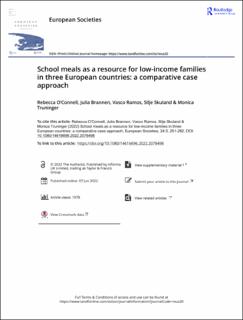| dc.contributor.author | O’Connell, Rebecca | |
| dc.contributor.author | Brannen, Julia | |
| dc.contributor.author | Ramos, Vasco | |
| dc.contributor.author | Skuland, Silje Elisabeth | |
| dc.contributor.author | Truninger, Monica | |
| dc.date.accessioned | 2023-02-06T11:44:10Z | |
| dc.date.available | 2023-02-06T11:44:10Z | |
| dc.date.created | 2022-09-09T08:38:38Z | |
| dc.date.issued | 2022-06-07 | |
| dc.identifier.citation | European Societies. 2022, 24 (3), 251-282. | en_US |
| dc.identifier.issn | 1461-6696 | |
| dc.identifier.issn | 1469-8307 | |
| dc.identifier.uri | https://hdl.handle.net/11250/3048542 | |
| dc.description.abstract | In the context of successive global crises and rising household food insecurity in wealthy European countries there is renewed attention to the role of school meals as a welfare intervention. However, little is known about the extent to which school meals are a resource for low-income families living in different contexts. Drawing on a mixed methods study of food in low-income families in three European countries, this paper adopts a realist ontological stance and an embedded case study approach to address this question. The research concerns low-income families with children aged 11–15 years in the aftermath of the 2008 financial crisis in the UK, Portugal and Norway. Based on a comparative, multi-layered analysis of macro-, meso- and micro-level contexts, we argue that publicly funded, nutritious school meals protect children from the direct effects of poverty on their food security, whilst underfunded and weakly regulated school food provision compounds children’s experiences of disadvantage and exclusion. The paper concludes with recommendations for public policies that conceptualise school meals as a collective resource, like education, to which young people as bearers of the right to food are entitled. | en_US |
| dc.language.iso | eng | en_US |
| dc.publisher | Routledge | en_US |
| dc.relation.ispartofseries | European Societies;Volume 24, 2022 - Issue 3 | |
| dc.rights | Attribution-NonCommercial-NoDerivatives 4.0 Internasjonal | * |
| dc.rights.uri | http://creativecommons.org/licenses/by-nc-nd/4.0/deed.no | * |
| dc.subject | School meals | en_US |
| dc.subject | Food insecurity | en_US |
| dc.subject | Low-income families | en_US |
| dc.subject | Children | en_US |
| dc.subject | Young people | en_US |
| dc.subject | European countries | en_US |
| dc.subject | Comparative case studies | en_US |
| dc.title | School meals as a resource for low-income families in three European countries: a comparative case approach | en_US |
| dc.type | Peer reviewed | en_US |
| dc.type | Journal article | en_US |
| dc.description.version | publishedVersion | en_US |
| dc.rights.holder | © 2022 The Author(s) | en_US |
| cristin.ispublished | true | |
| cristin.fulltext | original | |
| cristin.qualitycode | 2 | |
| dc.identifier.doi | https://doi.org/10.1080/14616696.2022.2078498 | |
| dc.identifier.cristin | 2050112 | |
| dc.source.journal | European Societies | en_US |
| dc.source.volume | 24 | en_US |
| dc.source.issue | 3 | en_US |
| dc.source.pagenumber | 251-282 | en_US |
| dc.relation.project | European Research Council: 337977 | en_US |

